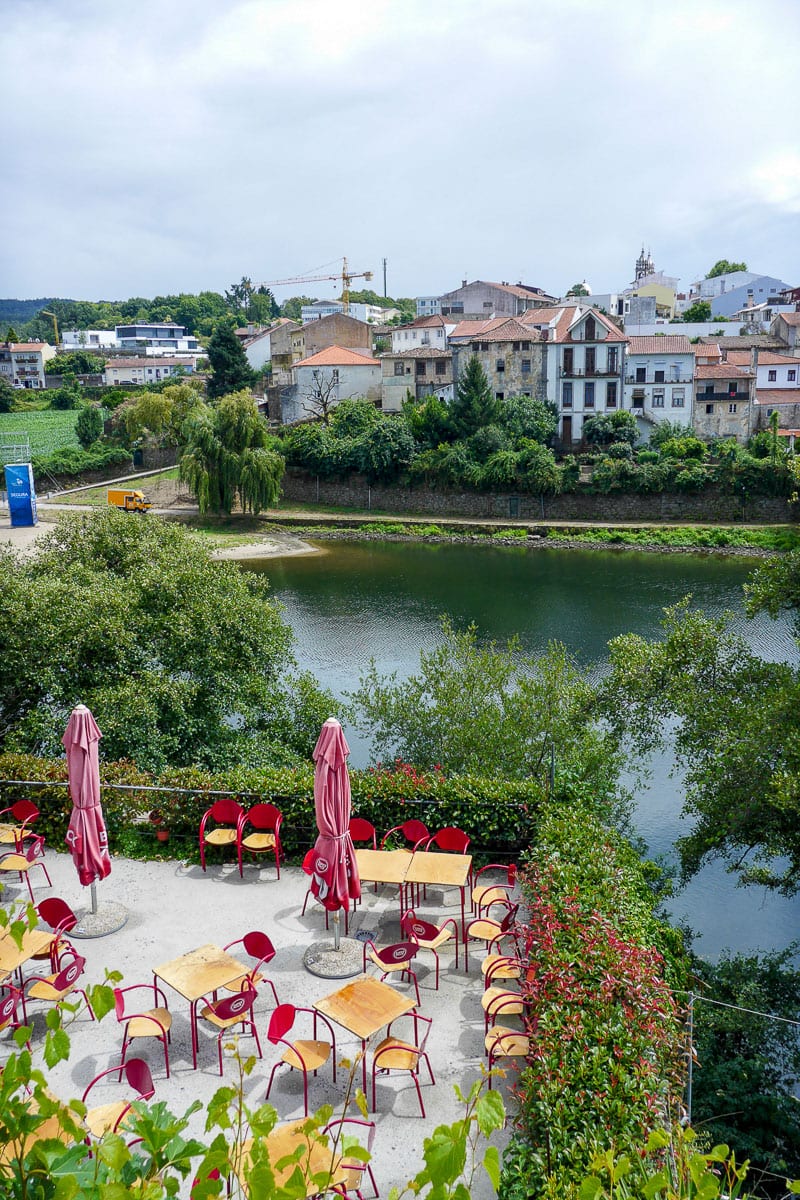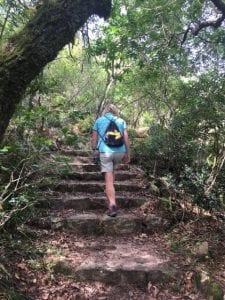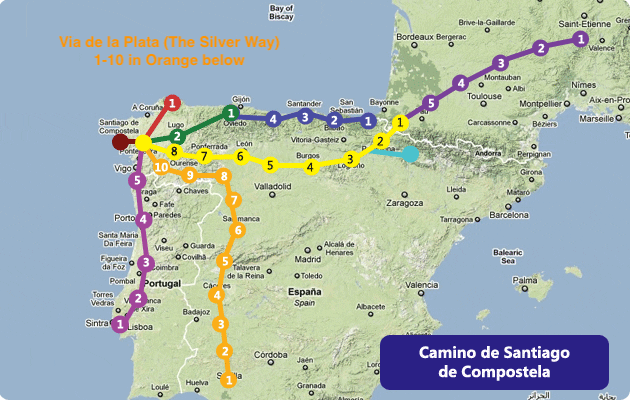Tackle the final stage of the Via de la Plata, the longest route of the Camino de Santiago. With 100 kilometres left until Santiago de Compostela the road is paved with cobblestones, the tracks are shaded by eucalypt forests and the villages are ready and waiting for pilgrims with open arms.
Camino de Santiago: Via de la Plata – The final 100kms
8 days / Self-guided walking
Ourense to Santiago de Compostela
Via de la Plata – The final 100kms
TRIP STYLE
DURATION/LENGTH
8 days/100 kms
DATES
Any date to suit you
START/END POINT
Ourense to Santiago de Compostela
GRADING
Moderate Walk
PRICE P/P TWIN SHARE
From EURO 875 / AUD 1,410

Beginning in Ourense, which is famous for its thermal springs, this final stage of the Via de la Plata takes in a beautiful stretch of Galician countryside on its approach to Santiago de Compostela. You’ll have a chance to taste Cea’s famous bread and Lalin’s traditional pig stew, all of which can be washed down with delicious local wines. The walking is varied, with some days involving quite strenuous ascents and descents, but these are rewarded with expansive views of the green countryside at the top and a cold Galician beer at the bottom. With plenty of friendly local faces and a relatively low number of pilgrims, this trail provides lots of opportunities for both reflection and interaction with the locals. Buen Camino!
Day 1 | Arrive in Ourense
Make your way today to Ourense, the third-largest city in the beautiful autonomous community of Galicia. This lively town is packed with pedestrianised streets lined with bars and restaurants that serve up some of Galicia’s traditional cuisine, like pulpo (octopus) and Galician stew, not to mention a range of mouth-watering local wines. Ourense is famous for its hot springs and is a popular destination for tourists wishing to bathe in its rejuvenating geothermal waters.
The city’s 13th-century Ourense Cathedral is a highlight and located in the medieval Old Town, where one could spend an entire day wandering the narrow, twisting streets. It’s also worth visiting the iconic Ponte Roman, with its trademark arches, which spans the River Minho. Soak up the atmosphere of the city tonight and be sure to get a good night’s rest for the beginning of your pilgrimage.
Day 2 | Ourense – Cea | 20 km / 6 hours
Ourense marks the final 100 kilometres to Santiago de Compostela, a wonderful stretch along any Camino path. Departing Ourense, make your way to the village of Cea, which is known for its famous ‘pan de Cea’ bread. Feel free to stock up once you arrive – you’re going to need the carbs on this journey.
This is the most challenging stage of the Via de la Plata pilgrimage and there are two routes to choose from. Pilgrims can either tackle Canedo, which involves a difficult climb on asphalt, or the Tallamancos route, which we recommend. This will take you on a long, steady climb along some lovely cobblestone roads past the village of Tallamancos and its Santa Maria Church. You’ll then walk past Sobreira and cross a 13th-century bridge over the Barbantino River before arriving in Cea.
Day 3 | Cea – Dozon | 21 km / 5 hours
Begin your day on the Via de la Plata by walking along shaded paths in the stunning, peaceful countryside. This is one of the quieter Caminos and you’re likely to have plenty of time to yourself, sometimes interrupted by friendly locals who are keen for a chat. Make your way to the 13th-century Mosterio de Oseira Monastery, then continue along a quiet rural road until you reach the village of Dozon, at which point you’ll have crossed into the province of Pontevedra.
Day 4 | Dozon – Lalin | 17 km / 4–5 hours
Fuel up at breakfast with plenty of coffee before you start your morning walk with a climb to the top of a hill for amazing views of the surrounding Galician landscape. The rest of the day continues in typical Via de la Plata fashion; quiet roads, forest paths and scenic, rolling countryside. Lalin is a small market town known for its traditional ‘cocido’, which is the premier Galician winter dish. It’s a chickpea stew with pork shoulder, ear and rib, as well as chorizo, potatoes, cabbage and whatever other parts of the pig are thrown in. Definitely one for the meat lovers! There’s even a festival – the Festa do Cocido – held in February that’s dedicated to the stew and the greater importance of the pig to the region.
Day 5 | Lalin – Silleda | 16 km / 4 hours
Enjoy a short, pleasant stage as you walk along undulating terrain through woodlands, farmlands and small villages. There are plenty of peaceful places to stop for a snack or picnic along the way. You’ll eventually enter Silleda, a village famous for both its cattle and agricultural fairs, including the Semana Verde, or Greek Week. It’s also home to Europe’s largest roofed street and close to the Fervenza do Toxa, which is one of Spain’s tallest waterfalls.
Day 6 | Silleda – Ponte Ulla | 20 km / 5 hours
Begin with an easy stroll towards Banedeira, a town famous for its tasty empanadas. We won’t judge if you spend a bit of time sampling the local goods. The day continues downhill through farmlands and villages and, just before descending, there’s an old castle that’s worth visiting for its 360-degree panoramic views. Ponte Ulla is known for its bridges, with an old Roman bridge allowing you to cross into town and – to your right as you descend – the Gundian Bridge, which was built in 1948 and lays claim as Spain’s highest railway bridge. It crosses the Ulla River between two cliffs and is a magnificent sight.
Day 7 | Ponte Ulla – Santiago de Compostela | 22 km / 6 hours
The final day of any pilgrimage is bittersweet and today is no exception. With pilgrims streaming into Santiago de Compostela from all parts of the country, the quietness of the Via de la Plata means you’ll enjoy a final chance for reflection as you approach Santiago Cathedral. Leaving Ponte Ulla, you’ll first climb towards Pico Sacro, with its Ermita de San Sebastian and breathtaking views. The last couple of kilometres to Santiago de Compostela are still relatively rural and it can be hard to imagine that you’re so close to a city. But yes, you are, and you’ll follow the narrow streets of the city to the square at Santiago Cathedral, where pilgrims sit and gaze up at the skyline-dominating towers.
Take some time to appreciate the moment before collecting your Compostela (certificate) from the nearby pilgrim’s office then it’s time to check-in to your accommodation and, most importantly, celebrate! Santiago is a fantastic city with a real buzz about it. There are plenty of restaurants and bars lining the streets of the Old Town and they are generally packed with locals and pilgrims, all smiling, all eating and drinking, all enjoying this special, World Heritage-listed place.
Day 8 | Finish in Santiago de Compostela
Your journey along the Via de la Plata comes to an end today after breakfast. Perhaps you’d like to continue on to Finisterre, either on foot or by bus, or maybe you’ve decided to spend an extra day or two enjoying Santiago.
Visit www.wanderingtheworld.com.au for more information.
Inclusions
- 7 nights accommodation, all carefully selected to enhance your Camino experience
- Private en-suite facilities
- Daily luggage transfers from hotel to hotel (1 x 20kg bag unless indicated otherwise)
- Daily breakfast
- Information packs with route maps and instructions on how to locate hotels
- Luggage identification tags
- Pilgrim’s passport
- Emergency contact details and 24/7 local on-the-ground support
- Pre-departure and ongoing support from Australian office
Optional Inclusions
- Three-course dinners with local wine
- Suggested rest days as outlined in itinerary or if required
- Upgraded accommodation including paradors, country properties and premium/high-end styles
- Private vehicle transfers to the trip’s starting point
- Single supplement for your own room
- Additional night’s accommodation before or after trip (please advise at time of booking)
Not Included
- Flights
- Travel to trip’s starting point
- Transfers not already outlined in detailed trip itinerary
- Lunches
Accommodation
We know from personal experience that a good night’s rest can make or break a trip, which is why we carefully hand-select all our accommodation. We ensure that our knowledge and firsthand experience of the best places to stay is passed on to all our walkers.
Your accommodation along the Camino is booked in advance, on a twin-share basis with private facilities, and chosen to make your pilgrimage experience as rewarding as possible. You may be staying in a refurbished farmhouse, some of which have been in the same family for centuries, or perhaps a boutique hotel with a chef who would not be out of place in a Michelin-starred restaurant. There are unique properties scattered throughout the different routes including converted monasteries, lighthouses and tiny B&Bs with the most generous hosts you could possibly imagine. Best of all, you’ll always have private en-suite facilities. Wherever you end up, you’ll be well looked after, warm and comfortable and, most importantly, ready to tackle the next day’s walk.
Single supplements are also available so you can enjoy your room with private en-suite. This supplement will apply if you are travelling alone or if there is no gender-share option. You can request a shared room through Wandering the World at the time of booking, however this is not guaranteed.
There are opportunities to upgrade to more luxurious lodgings in many places along the Camino. These are perfect for celebrating special occasions and milestones, or even to enhance your entire journey. We can recommend some very special, unique places to indulge in the Camino hospitality in spectacular style, so please ask us about these options when booking.
Food & Dining
The local cuisine is a definite highlight of your walk. The Camino regions are famous for their culinary delights, and you’ll end up exploring the destination using not only your feet, but also your taste buds.
Breakfast at your place of accommodation is usually continental style and may include cereals, yoghurt, bread, pastries, ham, tea, coffee and juices.
Lunch – at your own expense – will depend on where you are on your walk and what is available. It’s often purchased at a local café or bar, with choices along the trail perhaps including Spanish omelette (tortilla Espanola), tuna empanadas, soups or sandwiches (boccadillo). Alternatively, you may wish to enjoy a picnic in a perfect spot along the path.
Evening meals are a hearty, three-course affair known as the ‘pilgrims’ menu’. These usually consist of a salad or soup to start, followed by a choice of a meat or pasta dish, then finishing with a dessert. This is always accompanied by a bottle of local wine, of course. On occasion, the owner of the accommodation may be in the kitchen preparing the house special, which will not disappoint.
Most evening meals are included on guided group trips, and for self-guided itineraries Wandering the World can include as many evening meals as you wish. We may strongly recommend this in some places because it’s either been a long walking day or there are limited choices available in certain destinations. We can share our advice and talk to you about this at the time of booking. We can accommodate most dietary requirements, so please let us know in advance.
THE WALKING
This trip is a self-guided itinerary, ideal for groups and independent travellers who prefer to navigate in their own way and their own time.
You will be provided with an information pack including easy-to-read maps and instructions, complete with directions to guide you on the well-marked paths and tracks. On the Camino, you will be following the yellow arrows and Camino scallop shells, while the Chemin is marked with red and white stripes. This information pack will be available at your joining hotel on the first day of your trip.
TRIP GRADE
Moderate – This itinerary is carefully designed for easy-to-manage walking days that generally average less than 20 km, or approximately 4–6 walking hours. The surfaces are fairly even with moderate ascents and descents. A reasonable level of fitness is recommended.
Given you only need carry a lightweight day pack, this trip is very manageable for those who are new to walking holidays. Whatever your previous experience, preparation and training make all our walks more enjoyable.
LUGGAGE TRANSFERS
Wandering the World arranges a daily luggage transfer to maximise your comfort and enjoyment, so all you need to carry is a day pack. Luggage allowance is one bag per person of no more than 20 kg (13 kg on the Chemin). Your luggage must be left in the reception of your hotel before breakfast (8 am) each day.
Please note:
- It is essential to attach the bag tag provided to ensure your luggage is delivered to your next accommodation.
- Only one bag will be moved each day and additional charges will apply if your bag is heavier than 20 kg (13 kg on the Chemin).
- Should you require special arrangements for additional luggage transfers, these can be made ahead of time and must be paid as part of your final payment to Wandering the World.
GROUP SIZE
Wandering the World’s guided groups have a maximum group size of 12 participants. This small group size means that we have the flexibility to stay in a wider range of accommodations, can dine together in the evenings, have the freedom to walk alone or together, and there are more opportunities to get to know your travelling companions.
TRANSFERS/TAXIS
If, for any reason, you wish to shorten your walking day, there are options along the Camino and in the villages to arrange a taxi.
On some itineraries, there are times when Wandering the World may arrange a transfer for you or can do so at your request. This might happen where small villages do not have accommodation with private facilities, for example, or when we want to take you to a special country property that we know you are going to love. In this case, Wandering the World will either arrange a transfer for you or suggest a taxi.
Transfers on the Camino are common in parts. A simple procedure is outlined in your trip notes explaining the details of your private transfer, the designated meeting point and the agreed transfer time.
WEATHER
The weather and climate on the Camino can vary from country to country, region to region and, of course, from day to day. Each season has its own benefits, with long, warm and sunny days in spring and early summer, while early spring and late autumn tend to enjoy cooler walking temperatures. Some sections may be too hot for walking mid-summer, while others are more likely to be wet at certain times. The experts at Wandering the World can discuss your preferences and guide you when you are planning your trip.
Once you’ve started your walk, the weather can play an important role in your overall enjoyment of the journey. Checking the forecast can be a great help when planning your days. If you do strike hotter weather, leaving early to avoid the warmest part of the day will make a huge difference.
24/7 SUPPORT & CARE
Your information pack will include details of local emergency contacts and international contacts. We have local, on-the-ground support to provide any assistance you may require and we’ll also check-in with your hotel at the end of each day to ensure that you’ve arrived safely.
GETTING THERE / GETTING HOME
This itinerary begins in Ourense and ends in Santiago de Compostela.
The closest airports to Ourense are Santiago de Compostela Airport (100km), Vigo Airport (90km) or Porto Airport (170km)
From your airport of choice there are bus, train and flight options as per the links below.
Train bookings are recommended. Please note you can only book two months in advance of the date of travel.
Santiago de Compostela is linked to Ourense via bus, (approx 2hrs) See Monbus.es
There is a shuttle bus from/to the airport in Santiago, departing every 30min from the bus station (Estación de Autobuses), the train station (Estación de Ferrocarril) or the city centre (Plaza de Galicia). See empresafreire.com.
From Vigo airport take a bus to Travesia de Vigo (every 30 min) and then take a train to Ourense from nearby Vigo Guixar station (total travel time approximately 2 hours). See renfe.com.
From Porto airport there is a train connection between Vigo and Porto-Campanha (main train station) (taking 2h, sometimes with a change in Viana do Castelo). See www.cp.pt. There is also a train from Vigo to Ourense (approx. 2 hrs travel time). See renfe.com.
The easiest connection between Porto airport and Porto-Campanha or city centre is the metro. See: metrodoporto.pt.
Bus:
ALSA
Train:
Bus/Train :
Flights:
Also, check out: Skyscanner OR Spanish Airport Guide
Getting from Santiago de Compostela
From Santiago de Compostela there are bus, train and flight options as per the links above.
The airport is 11km from the city centre and there is a shuttle bus departing every 30 mins from Plaza de Galicia, the train station (Estación de Ferrocarril) and the bus station (Estación de Autobuses). See www.empresafreire.com.
INSURANCE
Insurance is compulsory for everyone who travels with Wandering the World. The insurance policy must include cover against personal accident, medical expenses, emergency repatriation and personal liability. Wandering the World recommends insurance coverage for cancellation to be taken at the same time your deposit is paid, as no exception to the cancellation provisions can be made.
BOOKING AND TRAVEL TERMS AND CONDITIONS
Wandering the World’s full booking terms and conditions are available upon request and will also accompany your initial invoice for deposit.
 “Compared to other routes I’ve walked, I felt like we had this Camino to ourselves. It was easy to misplace yourself, especially with the local trucks covering the arrows to Santiago on market day! I vividly remember the cocido, a traditional local stew, in Lalin – washed down nicely with some local vino. And, of course, the acclaimed empanadas just up the road in Bandeira – you can ask Reyne, a local, for them right in the middle of town”. – Glenyce, Founder of Wandering the World.
“Compared to other routes I’ve walked, I felt like we had this Camino to ourselves. It was easy to misplace yourself, especially with the local trucks covering the arrows to Santiago on market day! I vividly remember the cocido, a traditional local stew, in Lalin – washed down nicely with some local vino. And, of course, the acclaimed empanadas just up the road in Bandeira – you can ask Reyne, a local, for them right in the middle of town”. – Glenyce, Founder of Wandering the World.

In 2016 I had my first taste of one of the many camino routes, the last 150km of the Vila de la Plata. It was magical and I was hooked!
Judy W, 2016
